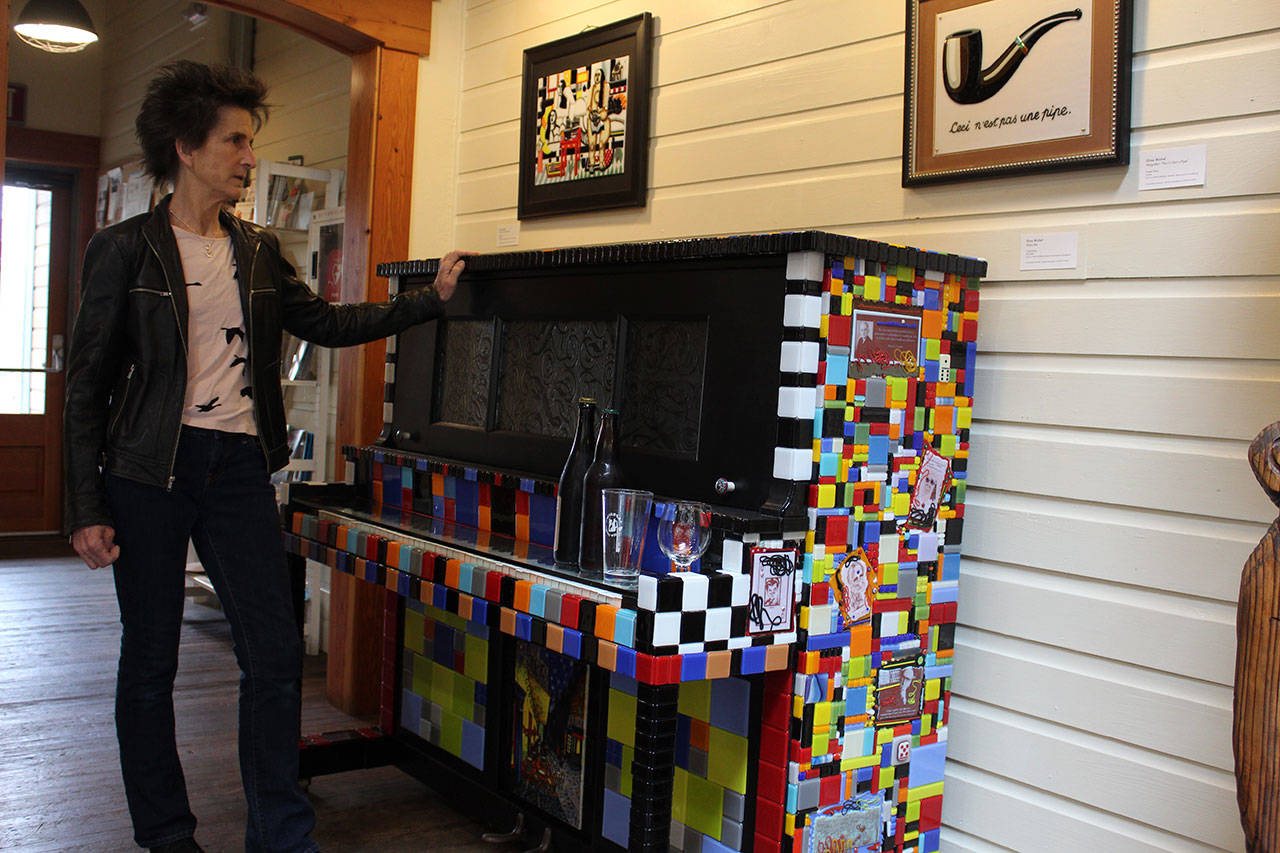A piano bar just popped up inside Bayview’s historic Cash Store Hub Gallery in Langley.
But don’t expect to get tipsy or tip the piano player to play your favorite tune. This piano bar is a work of art — silent in sound but a symphony of color, creativity, tiles and texture.
It’s one of many musical instruments comprising “Glassical Gas: A Collection of American Pop Culture in Fused Glass” by artist Gina Michel.
Michel, who moved to Whidbey from California about a year ago, covered the 1923 Gulbransen Player Piano with some 1,500 glass tiles she made herself.
She also created more elaborate tiles showing famous pianists — Liberace, Mozart, Stevie Wonder, Elton John — to name a few.
Electric guitars also hang as wall art. She calls a couple steampunk-inspired while another is the result of going “more natural.”
Called “Nanook’s Orca Guitar,” it’s a stunning representation of her style blending shapes and textures, all born from flat glass and fire.
“A lot of people are doing slumping and blowing glass,” she said. “My work has the three-dimensional aspect.”
She forms tiles and other glass shapes from sheets of art glass, precisely layers them, then uses high heat kilns to fuse them. Creating perfectly smooth, round edges from glass to form a whale’s eyes, teeth, fin and tail without any visible line, blip or blister is a technique mastered with time.
“They are all hand cut pieces,” she explained. “You have to build up the layer to get relief and the texture.”
Many of her pieces also contain little touches of recycled metal, faucet heads, tiny gears and other surprises.
Her first musical, glassical piece of art is a concert pedal harp she re-purposed with tiny shapes of fused glass that hug the harp’s form. Called “Super String Theory,” it hangs in California’s prestigious Colburn School of Music, which purchased it in 2014.
“I have a strong interest in music,” said Michel, who set-up her studio in Freeland. “I guess that’s why I started making some of these.”
In the early 1900s, Gulbransen Piano Company led the world in manufacturing player pianos. It used the trade mark of a baby on the floor pushing a piano pedal with the logo “Easy To Play.”
Michel saved the antique piano player from certain doom. It sat lonely and abandoned on a California house porch near her home, far too gone to ever be repaired.
Thus began her “piano project” in 2015.
“I didn’t have any idea what I was going to do with it,” Michel admitted. “It evolved as I went along.”
She removed its broken heart — the musical mechanism inside that once made the keys magically play themselves. That left a couple of holes to fill. And keys with no notes.
But the rollback door that had exposed the piano player’s innards still worked.
Inside that door now?
A built-in wine rack, slots for hanging wine glasses and a place for a martini glass or two.
Put a long clear piece of glass over the keyboards (cue the crescendo music here) and another kind of piano bar is born.
“People see the keyboard and they want to play,” Michel said. “Putting glass on it prevents that but it also makes a great place to rest your drink.”
Talk about a cocktail conversation piece.
Marian Myszkowski, director of programs at Goosefoot and curator of Hub Gallery, said it was the piano that initially grabbed her attention.
“When I came over to see the piano bar in person, she showed me the rest of her glass art,” Myszkowski said. “It just became obvious that Gina should have her own show.”
Myszkowski describes Michel’s work “bright, big, beautiful, thought- provoking and celebratory.”
Michel includes her love of animals in her first Whidbey show. One-quarter of the proceeds from sold art are being donated to WAIF, one of her favorite charities in her new home. She’s also put a guitar up for auction with all proceeds going to the animal shelter.
Michel started out as a painter, then discovered glass. She learned the art of stained glass, set up a studio, designed and constructed windows and taught classes. She calls this period of her many reincarnations “one of the more pleasant versions of myself.”
For three years, she served as a naval officer in Hawaii. After putting in 20 years as a reservist, she survived many crazy years as a motion picture and television script writer. Her last job — creating 70 episodes of CSI: Las Vegas.
She describes that work “about as much fun as doing a complicated income tax return in the middle of a mosh pit.”
She knew from visiting her sister on Whidbey that many glass artists live here.
“I wanted to get out of the rat race and do what I wanted.”
So she moved. Carefully, with a glass piano in tow.
• Gina Michel’s art show at Hub Gallery in the Bayview Cash Store is on display until April 15. Her piano will remain longer as part of a recycled art show.


